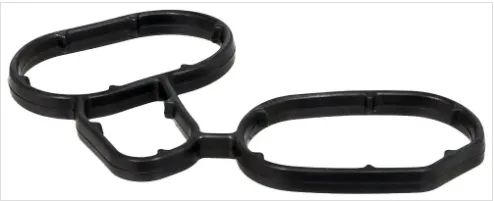The Complete Guide to Oil Pan Gaskets: Sealing Engine Leaks the Right Way
A vehicle’s engine relies heavily on proper sealing to function efficiently—and one of the most important seals is the oil pan gasket. This gasket creates a tight seal between the engine block and the oil pan, preventing motor oil from leaking out. Without a functioning oil pan gasket, you risk oil loss, reduced lubrication, engine overheating, and even internal damage.
Made from rubber, cork, silicone, or metal-reinforced materials, an oil pan gasket must endure high temperatures, constant pressure, and exposure to motor oil. Over time, these conditions can cause the gasket to wear out or crack, leading to leaks.

Common symptoms of a faulty oil pan gasket:
Oil spots under the vehicle
Visible oil along the gasket seam
Burning oil smell
Low oil levels between changes
Whether you’re driving a daily commuter or a high-performance vehicle, addressing oil leaks quickly is crucial. Fortunately, replacing an oil gasket is a manageable job for experienced DIYers and an essential task for professional mechanics.
Different Types of Gaskets: From LS Oil Pan Gasket to Oil Sump Gasket
Not all oil pan gaskets are created equal. Depending on your vehicle's design and engine type, you might encounter several gasket styles and configurations. Let’s break down a few of the most commonly used:
LS Oil Pan Gasket
The LS oil pan gasket is designed specifically for GM’s LS-series engines, widely known for their power and popularity in performance and swap applications. These gaskets are often molded rubber or silicone with integrated steel carriers to ensure strength and long-lasting performance.
Why it matters:
LS engines are frequently used in race cars, hot rods, and high-performance builds. A premium LS oil pan gasket ensures a leak-free seal even under extreme conditions and higher oil pressures.
Oil Sump Gasket
In some engines—particularly European and older models—the oil pan is referred to as an oil sump. A oil sump gasket serves the same purpose: sealing the junction between the engine and the oil reservoir. These gaskets are often used in vehicles with deeper or uniquely shaped oil pans.
Tips for oil sump gasket replacement:
Drain oil completely and clean the mating surfaces
Avoid using excessive sealant, which can squeeze into the oil system
Always torque bolts in a cross-pattern to avoid warping the pan
Transmission Oil Pan Gasket
Separate from the engine oil system, the transmission oil pan gasket seals the automatic transmission’s oil pan, which holds transmission fluid. These gaskets are crucial for keeping transmission fluid contained, ensuring smooth gear shifts and preventing slippage.
Signs of a failing transmission oil pan gasket:
Red or pink fluid leaking beneath the car
Transmission slipping or hesitating
Burnt-smelling fluid
Replacing a transmission oil pan gasket involves removing the transmission pan, draining the fluid, and carefully reinstalling the pan with a new gasket and fluid filter. While it's a bit more complex than an engine oil gasket, it's essential for transmission longevity.
Tips for Installing a Pan Seal Correctly
Regardless of the gasket type—whether it's an oil pan gasket, oil sump gasket, or transmission oil pan gasket—proper installation is critical to avoid leaks and future damage. That means more than just bolting the pan back into place; it requires cleanliness, precision, and patience.
How to Install an Oil Pan Gasket or Pan Seal Properly:
Thoroughly clean the oil pan and engine surface. Any oil residue, debris, or old gasket material must be completely removed.
Check for warping. A warped oil pan won't seal properly. Use a straight edge to verify flatness.
Apply gasket sealant only if specified. Many modern gaskets are designed to seal without added RTV sealant. Follow the manufacturer’s instructions carefully.
Use proper torque settings. Over-tightening bolts can warp the pan or crush the gasket, while under-tightening can lead to leaks.
Use a crisscross pattern. This ensures even pressure across the entire gasket during installation.
If you're replacing an oil gasket on a high-mileage engine, it’s a good idea to inspect surrounding seals and components. Often, leaks from a nearby valve cover gasket or rear main seal can mimic an oil pan leak.
Pro tip: For newer vehicles or performance engines, always use OEM or high-quality aftermarket gaskets. Cheap gaskets often lack proper sealing properties and fail prematurely.
Don't Ignore Gasket Leaks—Fix Them Right the First Time
Ignoring a leaking oil pan gasket or transmission oil pan gasket can result in oil starvation, overheating, or major engine and transmission damage. Fortunately, replacing gaskets is a cost-effective and practical fix when done properly.
Key Takeaways:
A damaged oil pan gasket can cause dangerous oil leaks and engine wear
The LS oil pan gasket and oil sump gasket serve specialized roles in performance and foreign vehicles
A faulty transmission oil pan gasket can lead to transmission failure if ignored
Always follow best practices when replacing a pan seal to ensure long-term performance
By understanding how gaskets work and when they need replacement, you’ll keep your engine running cleaner, cooler, and longer.
-
High-Quality Seal 12x22x5 for Industrial & Automotive Use | YJM Seal
समाचार Nov.25,2025
-
Seal 12x20x5: Precision Radial Shaft Seals for Industrial Reliability
समाचार Nov.24,2025
-
Seal 12x18x5: Essential Guide to Specifications, Applications & Vendors
समाचार Nov.24,2025
-
Understanding Seal 12 20 5: Applications, Specifications & Industry Insights
समाचार Nov.23,2025
-
Durable Oil Seal 85x110x12 – Reliable Sealing Solutions for Industry
समाचार Nov.23,2025
-
Durable and Precise Oil Seal 75x95x10 for Efficient Machinery | YJM Seal
समाचार Nov.22,2025
-
Durable Oil Seal 75x100x10 for Reliable Industrial Performance | YJM Seal
समाचार Nov.22,2025
उत्पाद श्रेणियाँ















